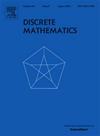四元数单位增益图邻接矩阵的行列式
IF 0.7
3区 数学
Q2 MATHEMATICS
引用次数: 0
摘要
本文利用作者最近引入的行列非交换行列式,给出了四元数单位增益图邻接矩阵行列式的组合描述。我们将四元数单位增益图定义为这样一种图,其中每条边的方向被分配一个四元数单位,其相反的方向被分配这个四元数单位的逆。首先,我们对单环和具有四元数单位增益的路径图的邻接矩阵的决定因素进行了详细的组合描述。随后,我们研究了四元数单位增益图邻接矩阵的行列式,其基础图由多个循环和/或路径图组成。我们引入了一种分解过程,这种图涉及通过切断与分支顶点相关的边获得的约简,以便每个约简的邻接矩阵等于其分量邻接矩阵的直接和。我们的结果定理提供了一种组合描述,用于用循环和图路径邻接矩阵的行列式来获得它们被分解的邻接矩阵的行列式。所得结果对于四元数单位增益图和复增益图都是新颖的,可以应用于各种类型的增益图,而不仅仅是单位增益图。本文章由计算机程序翻译,如有差异,请以英文原文为准。
The determinant of the adjacency matrix of a quaternion unit gain graph
In this paper, we present a combinatorial description of the determinant of the adjacency matrix of a quaternion unit gain graph using recently introduced row-column noncommutative determinants by one of the authors. We define a quaternion unit gain graph as a graph in which each edge's orientation is assigned a quaternion unit, and its opposite orientation is assigned the inverse of this quaternion unit. Initially, we provide detailed combinatorial descriptions of the determinants of the adjacency matrices for a single cycle and a path graph with quaternion unit gains. Subsequently, we investigate the determinant of the adjacency matrix for quaternion unit gain graphs whose underlying graphs consist of multiple cycles and/or path graphs. We introduce a decomposition procedure for such graphs involving reductions obtained by cutting off edges associated with branch vertices so that each reduction's adjacency matrix is equal to the direct sum of its components' adjacency matrices. Our resulting theorem offers a combinatorial description for obtaining the determinant of an adjacency matrix in terms of cycle and graph path adjacency determinants on which they are decomposed. The obtained results are novel for quaternion unit gain graphs and complex ones, and they could be applied to various types of gain graphs, not just those with unit gains.
求助全文
通过发布文献求助,成功后即可免费获取论文全文。
去求助
来源期刊

Discrete Mathematics
数学-数学
CiteScore
1.50
自引率
12.50%
发文量
424
审稿时长
6 months
期刊介绍:
Discrete Mathematics provides a common forum for significant research in many areas of discrete mathematics and combinatorics. Among the fields covered by Discrete Mathematics are graph and hypergraph theory, enumeration, coding theory, block designs, the combinatorics of partially ordered sets, extremal set theory, matroid theory, algebraic combinatorics, discrete geometry, matrices, and discrete probability theory.
Items in the journal include research articles (Contributions or Notes, depending on length) and survey/expository articles (Perspectives). Efforts are made to process the submission of Notes (short articles) quickly. The Perspectives section features expository articles accessible to a broad audience that cast new light or present unifying points of view on well-known or insufficiently-known topics.
 求助内容:
求助内容: 应助结果提醒方式:
应助结果提醒方式:


